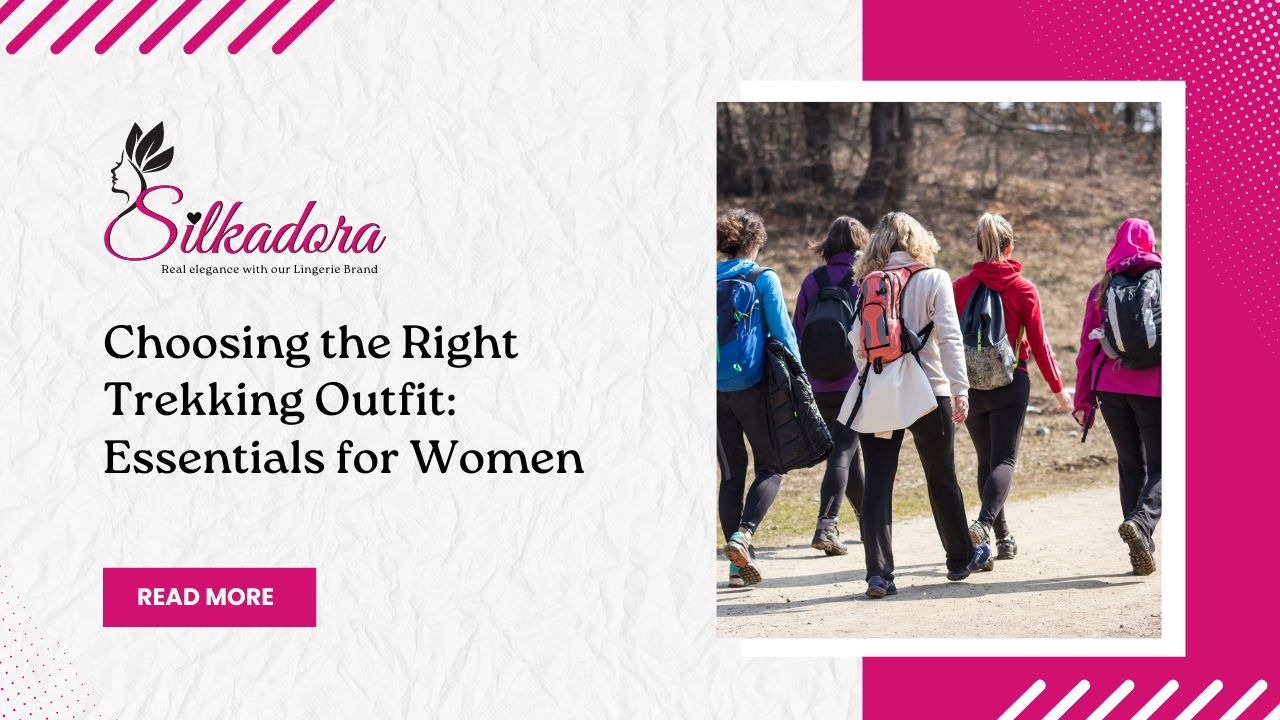Embarking on a trekking adventure is an exhilarating experience, allowing you to immerse yourself in nature and challenge your limits. However, the key to enjoying every step of the journey lies in choosing the right trekking outfit. For women explorers, finding the perfect combination of comfort, functionality, and style can make all the difference between a memorable hike or a struggle against the elements. In this guide, we will delve into essential tips and tricks for selecting the ideal trekking outfit that will keep you safe and comfortable on any trail. So lace up your boots and let’s dive into the world of trekking attire!
Why is the right trekking outfit important?
Choosing the right trekking outfit is crucial for a successful outdoor adventure. The clothing you wear can impact your comfort, safety, and overall enjoyment of the trek. A well-thought-out outfit can protect you from changing weather conditions, prevent chafing or blisters, and enhance your performance on the trail.
Additionally, wearing appropriate trekking attire can help regulate your body temperature and keep you comfortable throughout the hike. Whether it’s a lightweight moisture-wicking shirt to stay dry or insulated layers to combat chilly evenings, each piece plays a vital role in ensuring a pleasant experience outdoors.
Moreover, having the right gear can also boost your confidence and mindset during challenging sections of the hike. Feeling comfortable in what you’re wearing allows you to focus on enjoying the stunning scenery around you without distractions or discomfort holding you back.
Factors to consider when choosing a trekking outfit for women
When choosing the right trekking outfit for women, there are several factors to consider to ensure a comfortable and safe adventure. First and foremost, think about the climate and terrain you will be trekking in. Lightweight, moisture-wicking fabrics are essential for hot and humid conditions, while insulated layers are crucial for cold weather treks.
Consider the length of your trek and pack accordingly. Opt for versatile clothing items that can easily be layered or removed as needed. This allows you to regulate your body temperature throughout the day.
Additionally, pay attention to fit and mobility. Your outfit should allow for unrestricted movement while providing adequate coverage and protection from elements like sun exposure or insect bites.
Don’t forget about accessories such as hats, sunglasses, gloves, and scarves to shield yourself from the elements effectively. By carefully considering these factors when selecting your trekking outfit, you can enjoy a more enjoyable and successful outdoor experience.
Essential clothing items for a comfortable and safe trek
When it comes to choosing the right trekking outfit for women, having essential clothing items is crucial for a comfortable and safe journey. Start with moisture-wicking base layers that keep you dry and regulate body temperature. Opt for quick-drying materials like synthetic blends or merino wool to avoid chafing and discomfort.
Layer up with insulating mid-layers such as fleece jackets or down vests to stay warm in varying weather conditions. A waterproof and windproof outer shell is essential to protect against rain, snow, and harsh winds. Invest in quality hiking pants that offer flexibility, durability, and protection from rough terrain.
Don’t forget about accessories like hats, gloves, sunglasses, and buffs to shield yourself from the elements. Choose breathable socks designed for hiking to prevent blisters and ensure comfort during long treks. By prioritizing these essential clothing items in your trekking outfit selection, you can enjoy a safer and more enjoyable outdoor experience.
The importance of proper footwear and socks
Choosing the right footwear and socks for your trekking adventure is crucial to ensure comfort and prevent injuries. Your shoes should provide good ankle support, have a sturdy sole with good grip, and be waterproof to keep your feet dry in various terrains. Opt for hiking boots or trail shoes that are lightweight yet durable.
Investing in quality moisture-wicking socks can make a huge difference in preventing blisters and keeping your feet dry throughout the hike. Look for socks made of merino wool or synthetic materials that offer cushioning and ventilation. It’s recommended to wear two pairs of socks – a thin liner sock underneath a thicker outer sock – to reduce friction and enhance comfort.
Properly fitting footwear and well-chosen socks can significantly impact your overall trekking experience, so take the time to find the perfect combination that suits your foot shape and hiking style.
Layering for different weather conditions
When gearing up for a trek, it’s crucial to consider the ever-changing weather conditions you might encounter along the way. Layering your clothing is key to staying comfortable and prepared for whatever nature throws at you.
Start with a moisture-wicking base layer to keep sweat away from your skin and maintain warmth. Merino wool or synthetic materials work well for this purpose.
Add an insulating layer such as a fleece or down jacket to trap heat close to your body in colder temperatures. This layer can be easily added or removed depending on how chilly it gets.
Finish off with a waterproof and windproof outer shell to shield yourself from rain, snow, or strong winds. Look for breathable options that allow moisture to escape while keeping you dry.
By mastering the art of layering, you can regulate your body temperature effectively throughout your trek, ensuring a comfortable and enjoyable experience no matter what the weather gods have in store.
Must-have accessories for a successful trek
When gearing up for a trek, don’t overlook the importance of accessories to enhance your experience. A sturdy backpack with proper support is crucial for carrying essentials like water, snacks, and extra layers. Invest in a reliable hydration system to stay hydrated on the trail without hassle.
A high-quality headlamp or flashlight can be a lifesaver when navigating dark trails or setting up camp after sunset. Protect yourself from the sun with a wide-brimmed hat and sunglasses that offer UV protection. A lightweight and compact first aid kit should always be part of your gear in case of any minor injuries along the way.
Consider packing a multi-tool for unexpected repairs and adjustments during your trek. Additionally, bring along items like insect repellent, sunscreen, and a whistle for added safety measures while exploring the great outdoors.
Tips on finding the perfect fit and materials
When it comes to choosing the right trekking outfit, finding the perfect fit is crucial for comfort and performance. Opt for clothing that allows freedom of movement without being too loose or restrictive. Look for materials that are breathable, moisture-wicking, and quick-drying to keep you comfortable during long treks.
Consider pieces with adjustable features like waistbands, straps, or cuffs to customize the fit according to your body shape. Prioritize durability in materials like nylon, polyester blends, or merino wool which can withstand rugged terrains and frequent washings.
Try on different sizes and styles before committing to a purchase to ensure a proper fit. Don’t forget about layering options – choose items that can be easily layered together for versatility in changing weather conditions. Experiment with different brands and styles until you find what works best for your body type and personal preferences.
Remember that comfort is key when it comes to trekking outfits; don’t sacrifice functionality for style. Select materials that are lightweight yet durable enough to withstand the demands of outdoor activities.
Packing efficiently for a multi-day trek
When preparing for a multi-day trek, packing efficiently is key to ensuring you have everything you need without carrying unnecessary weight. Start by making a checklist of essential items like moisture-wicking clothing, a lightweight sleeping bag, and portable meals. Consider the climate and terrain to pack appropriate layers for warmth or cooling.
Opt for multipurpose items like a versatile scarf that can double as a head covering or extra layer. Pack compactly by rolling your clothes instead of folding them – it saves space and reduces wrinkles. Invest in lightweight gear such as a portable stove or collapsible water bottle to save on weight.
Prioritize essentials like first aid supplies, navigation tools, and emergency provisions in easily accessible pockets or compartments. Keep your pack organized with separate waterproof bags for clean clothes, dirty laundry, and trash disposal. Remember to distribute weight evenly to avoid strain on your back during long hikes.
By strategizing your packing approach with care and thoughtfulness, you can enjoy the journey ahead with peace of mind knowing you’re fully prepared for whatever challenges may arise along the trail.
Adjusting your outfit based on terrain and activity level
When trekking, adjusting your outfit based on the terrain and activity level is crucial for both comfort and safety. For rugged trails with uneven terrain, opt for durable and moisture-wicking clothing to keep you dry and protected from scratches or insect bites.
Consider wearing convertible pants that can easily be turned into shorts if the weather heats up or the terrain becomes less challenging. Layering is key when transitioning between different terrains – a breathable base layer, insulating mid-layer, and waterproof outer shell will help you adapt to changing conditions seamlessly.
For intense activities like climbing steep inclines or crossing rivers, choose lightweight and stretchy fabrics that allow for freedom of movement without weighing you down. Don’t forget to pack extra socks in case yours get wet – keeping your feet dry is essential to prevent blisters and discomfort along the journey.
Conclusion
Choosing the right trekking outfit is crucial for a successful and enjoyable outdoor experience. By considering factors like weather conditions, terrain, fit, and materials, women can ensure they are comfortable and safe during their trek. From moisture-wicking clothing to proper footwear and accessories, each item plays a vital role in enhancing the overall trekking experience.
Remember to pack efficiently for multi-day treks by layering clothing items for different weather conditions and adjusting your outfit based on the terrain and activity level. Finding the perfect fit and materials will not only provide comfort but also improve performance while on the trail.
With these essential tips in mind, women can confidently head out on their next adventure knowing they have chosen the right trekking outfit to conquer any challenge that comes their way. Happy trekking!










